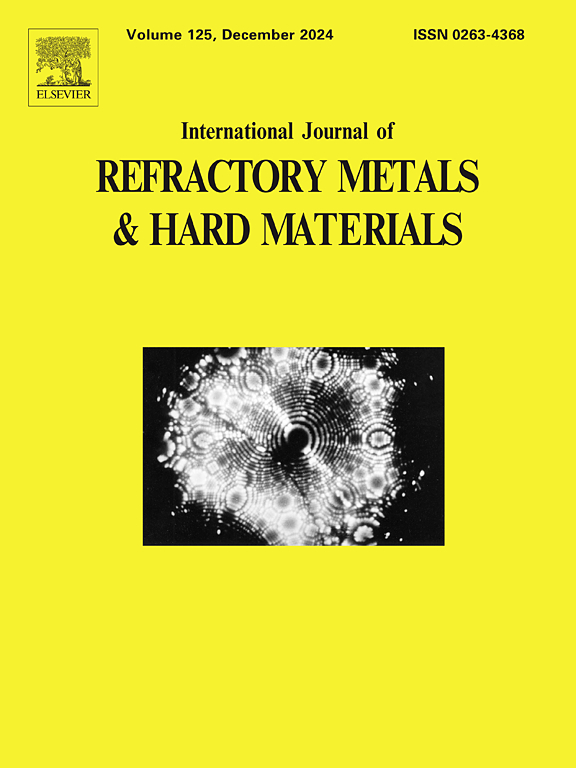High-speed Nanoindentation Data Analysis of WC-based Cemented Carbides using Gaussian Mixture Model Clustering and Skew-normal Mixture: Beyond Gaussian Deconvolution
IF 4.2
2区 材料科学
Q2 MATERIALS SCIENCE, MULTIDISCIPLINARY
International Journal of Refractory Metals & Hard Materials
Pub Date : 2024-10-13
DOI:10.1016/j.ijrmhm.2024.106917
引用次数: 0
Abstract
The mapping of micromechanical properties of heterogeneous materials with high-speed nanoindentation faces challenges in data interpretation and extraction of reliable phase properties. Gaussian deconvolution has commonly been used to treat this data, but problems arise when microstructures are fine compared to the indentation imprint size and the mechanical properties of the different phases are not extremely different. Recently machine-learning methods, such as clustering techniques, have emerged as good approaches to assess these challenges.
Within this context, it is important to understand the micromechanical properties of cemented carbides, materials usually referred to as hardmetals, but their complex microstructure poses challenges for assessment and interpretation. The study reveals insights from high-speed nanoindentation data treatment on hardmetals with different microstructures and binder compostion. The data has been statistically analyzed by means of a clustering method: Gaussian Mixture Model (GMM) and the fitting of a mixture of skew-normal distributions. Findings underscore the asymmetry in phase properties, and the challenges GMM encounters in some samples. The skew-normal method offers enhanced precision and addresses issues related to scatter in phase intersections, providing a more accurate representation of fine microstructural features. The combined approach of GMM and skew-normal proves consistent for reliable evaluation of micromechanical properties from nanoindentation maps in cemented carbides, and demonstrate the potential of this technique to be applied to novel hardmetal compositions as well as other composites.
使用高斯混合模型聚类和斜正态混合对基于 WC 的硬质合金进行高速纳米压痕数据分析:超越高斯解卷积
利用高速纳米压痕技术绘制异质材料的微观机械特性图,在数据解释和提取可靠的相特性方面面临挑战。高斯解卷积法通常用于处理此类数据,但当微观结构与压痕尺寸相比较细,且不同相的机械性能差异不大时,就会出现问题。在此背景下,了解硬质合金(通常被称为硬金属)的微观机械性能非常重要,但其复杂的微观结构给评估和解释带来了挑战。本研究揭示了对具有不同微观结构和粘合剂成分的硬质合金进行高速纳米压痕数据处理后得出的见解。通过聚类方法对数据进行了统计分析:高斯混合模型 (GMM) 和斜正态分布混合拟合。研究结果强调了相特性的不对称性,以及 GMM 在某些样本中遇到的挑战。斜正态分布法提高了精确度,解决了与相交散点有关的问题,更准确地反映了微观结构特征。事实证明,GMM 和斜正态相结合的方法可以从硬质合金的纳米压痕图中可靠地评估微观机械性能,并证明了该技术应用于新型硬金属成分和其他复合材料的潜力。
本文章由计算机程序翻译,如有差异,请以英文原文为准。
求助全文
约1分钟内获得全文
求助全文
来源期刊
CiteScore
7.00
自引率
13.90%
发文量
236
审稿时长
35 days
期刊介绍:
The International Journal of Refractory Metals and Hard Materials (IJRMHM) publishes original research articles concerned with all aspects of refractory metals and hard materials. Refractory metals are defined as metals with melting points higher than 1800 °C. These are tungsten, molybdenum, chromium, tantalum, niobium, hafnium, and rhenium, as well as many compounds and alloys based thereupon. Hard materials that are included in the scope of this journal are defined as materials with hardness values higher than 1000 kg/mm2, primarily intended for applications as manufacturing tools or wear resistant components in mechanical systems. Thus they encompass carbides, nitrides and borides of metals, and related compounds. A special focus of this journal is put on the family of hardmetals, which is also known as cemented tungsten carbide, and cermets which are based on titanium carbide and carbonitrides with or without a metal binder. Ceramics and superhard materials including diamond and cubic boron nitride may also be accepted provided the subject material is presented as hard materials as defined above.

 求助内容:
求助内容: 应助结果提醒方式:
应助结果提醒方式:


